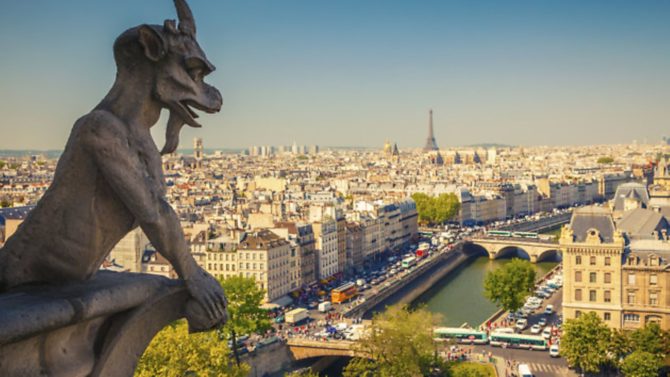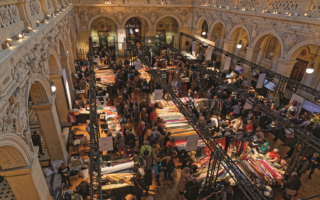Île-de-France region guide

An insider’s guide to Île-de-France in northern France, including the main attractions to visit on holiday, the best towns and villages to live in, the major festivals and events, and buying property in Île-de-France

Located in central northern France, Île-de-France is home to France’s capital city Paris and so is one of the most visited areas of France. Île-de-France borders Nord-Pas-de-Calais-Picardy, Normandy, Centre-Val de Loire, Burgundy-Franche-Comté and Alsace-Champagne-Ardenne-Lorraine.
Paris is one of the most-visited cities in the world and is home to major attractions such as the Eiffel Tower, the Louvre and the Notre-Dame cathedral. There is always something to do in Paris with numerous festivals, exhibitions and events throughout the year. Outside the city, other tourist attractions include Disneyland Paris, the Palace of Versailles, the Stade de France and Fontainebleau.
The other departments in Île-de-France divide into the Petite Couronne (the inner ring) – Hauts-de-Seine, Seine-St-Denis and Val de Marne – and the Grande Couronne (outer ring) – Essonne, Seine-et-Marne, Val-d’Oise and Yvelines. They are home to a number of former royal forests and parks, regional natural parks, historic towns and riverside villages.
Departments in Île-de-France
Paris is the capital city of France and is one of the most visited destinations in the world. It is made up of 20 arrondissements and is home to the Eiffel Tower and the Louvre.
Seine-et-Marne is largely agricultural land but also includes Disneyland Paris, the royal town and forest of Fontainbleau and the medieval town of Provins. The capital is Melun.
Yvelines lies to the east of Paris and is also largely rural. Its main attraction is the magnificent Palais de Versailles. The town of Versailles is the capital.

Hauts-de-Seine lies west of Paris and is a small, densely populated department home to La Défense, the largest purpose-built business district in Europe. The capital is Nanterre.
Essonne lies to the south of Paris and is a department of two halves. The north is extremely urbanised with towns becoming part of wider Paris while the south is still rural. The capital is the town of Évry.
Seine-et-Denis is a leafy suburb lying to the north-east of Paris and is home to the Stade de France and the Basilique st-Denis, the burial place of almost all of the kings of France. The capital is Bobigny.
Val-de-Marne is named after the Marne River which runs through the department, along with the River Seine. It is home to the Bois de Vicennes park popular with Parisians escaping the city. The capital is Créteil.

Val-d’Oise lies north of Paris and has three national forests and two regional natural parks. Many artists, including Van Gogh and Rousseau, have lived here. The capital is Pontoise.

Getting there
Plane: Paris has two international airports both with regular flights from the UK and across the world. Paris-Charles de Gaulle is located in the north of Paris while Paris-Orly is in the south.
Train: The Eurostar runs regularly from London to Paris and takes just over two hours.
Car: Île-de-France is easily reached by car and is around 2 hours from Le Havre port and just under 3 hours from Calais

Places to visit in Île-de-France
The capital city and largest city in France is Paris. It is one of the most visited tourist destinations in the world with around 45 million visitors each year. It is known for its beautiful Haussmann buildings and architecture and wide boulevards like the Champs-Élysées. Some of the city’s most popular attractions are the Eiffel Tower, the Louvre museum where you can see the Mona Lisa, the Arc de Triomphe, the Notre-Dame cathedral and the Sacré-Coeur. For more unusual sights try the Paris catacombs or the Père Lachaise cemetery. The city is divided into 20 arrondissements and the méteo makes it easy to get around the city.
Read more: 8 places in Paris the tourists miss
Disneyland Paris is located in Marne-la-Vallée, east of Paris, and is the most visited theme park in France. The resort covers 19km² and encompasses hotels, shopping, dining and entertainment venues. Opened in 1992, the resort is particularly popular with British families who come to meet Mickey, Minnie and their other favourite Disney characters.
The main royal residence to visit in Île-de-France is the magnificent Palace of Versailles was built by Louis XIV in the 17th century and was home to the royal court. It has been on the UNESCO World Heritage list for 30 years. As well as the impressive palace you can explore the beautiful gardens designed by André le Nôtre.
A royal hunting lodge and chapel was built in the hamlet of Fontainebleau in the 12th century and later in the 16th century the grand Château de Fonatinebleau was built and became a favourite royal residence. Now it is a national museums and a UNESCO World Heritage Site. The surrounding forest was a royal hunting park but is now popular with hikers and riders
The medieval town of Provins in Seine-et-Marne is an UNESCO World Heritage Site. It was built to hold fairs in the Middle Ages and is the best preserved town of its type in France. Don’t miss the medieval fair in June.
Sports fans can take a tour of the Stade de France, in St Denis, which was built for the 1998 World Cup and now hosts international football and rugby matches. Or head to Roland Garros to watch the French Open.
The marina at Nogent-sur-Marne, along the Marne River, has many colourful restaurants and bars along the river and a museum. In the 19th century, the riverbanks would draw the working classes out of Paris to enjoy the cheap wine produced here (known as guinget) and the local music halls were termed guingettes after the popular tipple. The neighbourhood is popular with families due to its good schools, open space and village-style neighbourhoods.
Things to do in Île-de-France
Museum-lovers aren’t short of museums to visit in Île-de-France. Paris boasts one of the most-visited museums in the world, the Louvre where the Mona Lisa hangs, along with the Musée d’Orsay, the Pompidou centre and the Petit Palais to name just a few. Outside of Paris there is the Musée Claude Debussy and the Château de Monte Cristo in Yvelines, the French Museum of Photography in Essonne and the Absinthe Museum in Val-d’Oise. The Gothic Basilique St-Denis is the burial place of almost all the kings of France and was an extremely revolutionary piece of architecture of its time
Read more: 10 Paris museums you can visit for free
Within Paris there are a number of parks, including the Jardins de Luxembourg and Parc des Buttes-Chaumont. The largest green space in Paris is the Parc de la Villette, covering 55 hectares with 10 gardens. Just outside the city is the Bois de Boulogne with lots of paths for joggers as well as a pony club, boats for hire and roller-skating park, and the Bois de Vincennes, a 995-hectare park with lakes, children’s farm, zoological park, racecourse and theatres.
Read more: Lose yourself in these hidden parks in Paris
There are a number of forests and regional parks in Île-de-France, many of which were once royal residences but are now popular with hikers and horse riders. These include the Fôret de Rambouillet, the Forêt de Sénart, the Forêt de Fontainebleau and the regional parks of Haute-Vallée de Chevreuse and Vexin-Francais.
There are numerous festivals, exhibitions and events in Paris throughout the year, but some of the more famous ones include Nuit Blanche, Paris Plages and the Paris marathon. There are a number of jazz and other music festivals in the parks and along the Seine.
Read our pick of what’s on in France each month
Like this? You might enjoy:
Our guides to all of France’s regions
Share to: Facebook Twitter LinkedIn Email
More in Ile-de-France Region Guide


